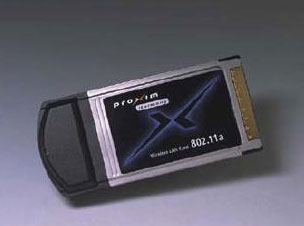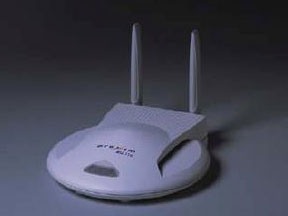Learn about basic WLAN devices
Wireless network ( Wireless Local Area Network ) is the preferred wireless network system by providing high-speed data transmission, with long distances without worrying about wires, cables .
In this article, readers will be familiar with basic WLAN devices.Basic WLAN devices include wireless network cards, wireless access points ( Access Points ), and WBridge (Wireless Bridge).
Wireless network card

Wireless network cards are not much different from those used in wired LANs.Wireless network cards exchange information with the network operating system through a dedicated controller.Thus, any application can use wireless networks to transfer data.However, unlike wired network cards, wireless network cards do not need any wiring.Wired network cards can use ISA slots (currently less used) or PCI slots (commonly used) on desktop computers or use the PCMCIA slot on laptops.Wireless cards often have an external antenna that can be attached to a wall or a location in the room.
Wireless access points (Access Point)

AP ( Acsses Point ) wireless access points create coverage areas, connecting mobile nodes to wired LAN infrastructures.Because access points allow extended coverage, WLAN wireless networks can be deployed in either a building or a university campus, creating a large wireless access area.These access points not only provide information exchange with wired networks but also filter traffic and perform bridging functions with other standards.Filter function helps preserve bandwidth on radio channels by eliminating excess traffic.
Because of the asymmetric pairing bandwidth between wireless and wired information, access points need to have proper buffers and memory resources.Buffers are mainly used to store data points at access points when a mobile node tries to move out of coverage or when a mobile node operates in low power mode.Access points communicate with each other over wired networks to manage mobile nodes.An uncontrolled access point accesses from multiple mobile nodes (which means it can operate with a distributed random protocol like CSMA).However, a centralized multi-access protocol controlled by an access point has many advantages.Common wired network interface options with access points include 10Base2, 10BaseT, ADSL modem, ISDN.
WBridge - Wireless Bridge

WBridge (Wireless Bridge) is similar to wireless access points unless they are used for external channels.Depending on distance and region, external antenna is required.WBridge is designed to connect networks together, especially in buildings up to 32 km away.
WBridge provides a fast and inexpensive method of using cable, or leased line (lised-line) and is often used when traditional wired connections cannot be made or difficult as across rivers, rugged terrain, private areas, highways . Unlike cable links and specialized telephone circuits, WBridge can filter traffic and ensure that wireless networks can Good connection without losing necessary traffic.
More article: Deploying, implementing a WLAN
You should read it
- ZyXEL's NWA-3166 wireless access point
- Instructions for changing settings in Wi-Fi Router
- 7 best 802.11g wireless broadband routers
- How to turn a Raspberry Pi into a wireless access point
- 4 steps to set up your home wireless network
- Protect yourself from wireless access points
- Share your wireless home network
- 4 tips for building better wireless networks
May be interested
- Learn SSID and wireless network
 the ssid (short for service set identifier) is the primary name associated with 802.11 wireless lan (wlan) including home and public hotspots. client devices use this name to identify and connect to a wireless network.
the ssid (short for service set identifier) is the primary name associated with 802.11 wireless lan (wlan) including home and public hotspots. client devices use this name to identify and connect to a wireless network. - 10 simple CSS codes you can study in 10 minutes
 when using html for web programming, you expect the website to look more professional and convenient. css is the best way to do that. here are 10 css codes that you can learn in 10 minutes.
when using html for web programming, you expect the website to look more professional and convenient. css is the best way to do that. here are 10 css codes that you can learn in 10 minutes. - Learn about the concept of QoS on routers
 in the following article, we will introduce and guide you to learn about the concept of qos - quality of service on router devices ...
in the following article, we will introduce and guide you to learn about the concept of qos - quality of service on router devices ... - Learn to use lesson 18 computer - Basic troubleshooting techniques
 in the process of using computers, each of us is more or less many have experienced problems with their devices, from basic to complex.
in the process of using computers, each of us is more or less many have experienced problems with their devices, from basic to complex. - Should choose wired LAN or wireless LAN?
 wireless connectivity is something everyone loves nowadays. who doesn't love the freedom it offers? but there are a few things to consider when comparing wireless lan (wlan) and wired lan.
wireless connectivity is something everyone loves nowadays. who doesn't love the freedom it offers? but there are a few things to consider when comparing wireless lan (wlan) and wired lan. - Basic difference between GiFi and WiFi
 this article will compare gifi and wifi by describing the basic difference between gifi technology and wifi. basically, gifi is used for gigabit wireless and wifi is used for wireless fidelity or wlan.
this article will compare gifi and wifi by describing the basic difference between gifi technology and wifi. basically, gifi is used for gigabit wireless and wifi is used for wireless fidelity or wlan. - Configure wireless connection of Windows Vista from CLI with netsh wlan
 surely one thing that you absolutely can configure wireless networking in windows vista using gui but it's not always simple for most people. how to configure wirelessly from a command line utility
surely one thing that you absolutely can configure wireless networking in windows vista using gui but it's not always simple for most people. how to configure wirelessly from a command line utility - Learn to use lesson 2 computer - Basic parts of the computer
 basic components make up a desktop system including computer case, monitor, keyboard, mouse, motherboard and power cord.
basic components make up a desktop system including computer case, monitor, keyboard, mouse, motherboard and power cord. - Basic steps for creating plugins with jQuery
 in the article below, we will introduce and guide you a few basic steps to create a plugin using jquery. whether you are a beginner to learn about web development or have been exposed to javascript for a long time, jquery is a great framework and not to be missed ...
in the article below, we will introduce and guide you a few basic steps to create a plugin using jquery. whether you are a beginner to learn about web development or have been exposed to javascript for a long time, jquery is a great framework and not to be missed ... - Basic information about network equipment
 in order to be able to use and connect networks to computers, we need dedicated network installation devices. including 5 basic names including repeater, hub, switch, router and gateway. each device has different characteristics as well as ability to work.
in order to be able to use and connect networks to computers, we need dedicated network installation devices. including 5 basic names including repeater, hub, switch, router and gateway. each device has different characteristics as well as ability to work.










 Differentiate indicator lights in Cisco Switch
Differentiate indicator lights in Cisco Switch Sharing resources on the 'multi-system' network
Sharing resources on the 'multi-system' network Summary of DSL technology
Summary of DSL technology CSU / DSU - an essential component of a WAN
CSU / DSU - an essential component of a WAN Point to Point Protocol (PPP)
Point to Point Protocol (PPP) Basic knowledge of Virtual LANs
Basic knowledge of Virtual LANs